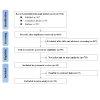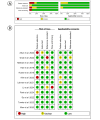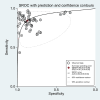Machine Learning and Deep Learning for Diagnosis of Lumbar Spinal Stenosis: Systematic Review and Meta-Analysis
- PMID: 39715552
- PMCID: PMC11704645
- DOI: 10.2196/54676
Machine Learning and Deep Learning for Diagnosis of Lumbar Spinal Stenosis: Systematic Review and Meta-Analysis
Abstract
Background: Lumbar spinal stenosis (LSS) is a major cause of pain and disability in older individuals worldwide. Although increasing studies of traditional machine learning (TML) and deep learning (DL) were conducted in the field of diagnosing LSS and gained prominent results, the performance of these models has not been analyzed systematically.
Objective: This systematic review and meta-analysis aimed to pool the results and evaluate the heterogeneity of the current studies in using TML or DL models to diagnose LSS, thereby providing more comprehensive information for further clinical application.
Methods: This review was performed under the PRISMA (Preferred Reporting Items for Systematic Reviews and Meta-Analyses) guidelines using articles extracted from PubMed, Embase databases, and Cochrane Library databases. Studies that evaluated DL or TML algorithms assessment value on diagnosing LSS were included, while those with duplicated or unavailable data were excluded. Quality Assessment of Diagnostic Accuracy Studies 2 was used to estimate the risk of bias in each study. The MIDAS module and the METAPROP module of Stata (StataCorp) were used for data synthesis and statistical analyses.
Results: A total of 12 studies with 15,044 patients reported the assessment value of TML or DL models for diagnosing LSS. The risk of bias assessment yielded 4 studies with high risk of bias, 3 with unclear risk of bias, and 5 with completely low risk of bias. The pooled sensitivity and specificity were 0.84 (95% CI: 0.82-0.86; I2=99.06%) and 0.87 (95% CI 0.84-0.90; I2=98.7%), respectively. The diagnostic odds ratio was 36 (95% CI 26-49), the positive likelihood ratio (LR+) was 6.6 (95% CI 5.1-8.4), and the negative likelihood ratio (LR-) was 0.18 (95% CI 0.16-0.21). The summary receiver operating characteristic curves, the area under the curve of TML or DL models for diagnosing LSS of 0.92 (95% CI 0.89-0.94), indicating a high diagnostic value.
Conclusions: This systematic review and meta-analysis emphasize that despite the generally satisfactory diagnostic performance of artificial intelligence systems in the experimental stage for the diagnosis of LSS, none of them is reliable and practical enough to apply in real clinical practice. Further efforts, including optimization of model balance, widely accepted objective reference standards, multimodal strategy, large dataset for training and testing, external validation, and sufficient and scientific report, should be made to bridge the distance between current TML or DL models and real-life clinical applications in future studies.
Trial registration: PROSPERO CRD42024566535; https://tinyurl.com/msx59x8k.
Keywords: AI; LSS; ML; artificial intelligence; deep learning; diagnosis; diagnostic; early detection; lumbar; lumbar spinal stenosis; machine learning; older adult; predictive model; spine stenosis.
©Tianyi Wang, Ruiyuan Chen, Ning Fan, Lei Zang, Shuo Yuan, Peng Du, Qichao Wu, Aobo Wang, Jian Li, Xiaochuan Kong, Wenyi Zhu. Originally published in the Journal of Medical Internet Research (https://www.jmir.org), 23.12.2024.
Conflict of interest statement
Conflicts of Interest: None declared.
Figures






Similar articles
-
Performance of Artificial Intelligence in Diagnosing Lumbar Spinal Stenosis: A Systematic Review and Meta-Analysis.Spine (Phila Pa 1976). 2025 May 15;50(10):E179-E196. doi: 10.1097/BRS.0000000000005174. Epub 2024 Oct 11. Spine (Phila Pa 1976). 2025. PMID: 39451133
-
Qualitative versus quantitative lumbar spinal stenosis grading by machine learning supported texture analysis-Experience from the LSOS study cohort.Eur J Radiol. 2019 May;114:45-50. doi: 10.1016/j.ejrad.2019.02.023. Epub 2019 Feb 19. Eur J Radiol. 2019. PMID: 31005175
-
Machine and Deep Learning for Tuberculosis Detection on Chest X-Rays: Systematic Literature Review.J Med Internet Res. 2023 Jul 3;25:e43154. doi: 10.2196/43154. J Med Internet Res. 2023. PMID: 37399055 Free PMC article.
-
Can a Deep-learning Model for the Automated Detection of Vertebral Fractures Approach the Performance Level of Human Subspecialists?Clin Orthop Relat Res. 2021 Jul 1;479(7):1598-1612. doi: 10.1097/CORR.0000000000001685. Clin Orthop Relat Res. 2021. PMID: 33651768 Free PMC article.
-
An Artificial Intelligence-Based Support Tool for Lumbar Spinal Stenosis Diagnosis from Self-Reported History Questionnaire.World Neurosurg. 2024 Jan;181:e953-e962. doi: 10.1016/j.wneu.2023.11.020. Epub 2023 Nov 10. World Neurosurg. 2024. PMID: 37952887
Cited by
-
Machine learning prediction of extended length of stay following endoscopic decompression for lumbar spinal stenosis: A retrospective cohort study.Digit Health. 2025 Jul 22;11:20552076251361658. doi: 10.1177/20552076251361658. eCollection 2025 Jan-Dec. Digit Health. 2025. PMID: 40718407 Free PMC article.
References
-
- Lurie J, Tomkins-Lane C. Management of lumbar spinal stenosis. BMJ. 2016;352:h6234. doi: 10.1136/bmj.h6234. https://europepmc.org/abstract/MED/26727925 - DOI - PMC - PubMed
-
- Ravindra VM, Senglaub SS, Rattani A, Dewan MC, Härtl R, Bisson E, Park KB, Shrime MG. Degenerative lumbar spine disease: estimating global incidence and worldwide volume. Global Spine J. 2018;8(8):784–794. doi: 10.1177/2192568218770769. https://journals.sagepub.com/doi/abs/10.1177/2192568218770769?url_ver=Z3... 10.1177_2192568218770769 - DOI - DOI - PMC - PubMed
-
- Kreiner DS, Shaffer WO, Baisden JL, Gilbert TJ, Summers JT, Toton JF, Hwang SW, Mendel RC, Reitman CA, North American Spine Society An evidence-based clinical guideline for the diagnosis and treatment of degenerative lumbar spinal stenosis (update) Spine J. 2013;13(7):734–743. doi: 10.1016/j.spinee.2012.11.059.S1529-9430(13)00423-3 - DOI - PubMed
Publication types
MeSH terms
LinkOut - more resources
Full Text Sources
Medical

